5 Steps to Start Freelance Copywriting as a Side Hustle
When I started out as a freelance copywriter, I had absolutely no idea what I was doing. I didn’t know how to find work. I didn’t know how much to charge people. I didn’t even know how to create an invoice. But I ended up freelancing for five years, and after that, I founded my own copywriting agency. I made plenty of mistakes when starting out, but some of the stuff I tried did actually have some success. If I had to do it all again, these are the first five steps I would take to start freelance copywriting as a side hustle.
A quick note before we get started: the advice in this guide depends on your current work situation. If you want to do a bit of freelancing on the side of your current job, you might want to check first with your employer if it’s OK to a) do some freelance work on the side and b) broadcast your intentions online. Every company and boss is different, and some may not approve.
Table of Contents
1. Update your LinkedIn profile
It’s time to tell people what you do!
Let’s update your headline on LinkedIn, which is the little byline underneath your name that everyone can see. For bonus points, try including ‘freelance copywriter’ at the front of your headline. It has a 120 character cut-off point, so if you want potential copywriting clients to find you on LinkedIn, you’ve got to make the copywriter bit as visible as possible.
You should also add a new career position to your profile. Be sure to use that keyword again – ‘freelance copywriter’ – so prospective clients can easily find you. If you’re targeting a specific niche – landing pages, B2B, fintech – then make sure you include those keywords too. It’s worth taking a look at other freelance copywriter’s profiles to see how they do it.
2. Make a one-page website
Even if your website is just a way to show clients your portfolio, it’s worth having. And the good news is that now it’s easier than ever to make a simple website. For a freelance copywriter, I would recommend Squarespace. They have a lot of ready-made templates aimed at freelancers and creatives, and I personally find it more user-friendly than Wix (and certainly WordPress).
Plus, writing down your raison d’etre, services, portfolio and story really help define you and your new career. It can help you nail down your USP, your motivations for doing this and why people should hire you.
3. Write every week (even if you don’t have any clients yet)
If you’re just starting out as a freelance copywriter, it’s probably reasonable to assume you don’t have many clients yet. But that doesn’t mean you shouldn’t be writing whenever you can. The best way to improve your copywriting is by practising. This is particularly important for someone like you because presumably you don’t already practise copywriting every day in your current role.
It’s tricky to find time alongside a full-time job to practise writing. So try clearing one, or ideally several ‘writing slots’ throughout your working week. Reserving this time will make sure you’re getting the practice you need to get better.
But with no clients, what can you write about? Well, you could try collecting some examples of copywriting from different companies and rewrite them. Write some articles for your LinkedIn profile – it doesn’t matter the topic. You could even reach out to companies and offer to do small projects for free. You have to keep writing consistently, whether manually or by using an advanced online writing tool. Otherwise, you’ll never improve and won’t pick up any work.
When I read back some of my work from early in my career, I cringe. And I imagine I’ll probably be doing the same thing to my current work in a few years’ time. But I would be worried if it was any other way because it shows how much I’ve improved over the years. I only did that through practising every day.
4. Work out your rate
Yep, this part of the freelancing process is a total nightmare – and it doesn’t get that much easier. When I first started freelancing, this felt like total guesswork on my part. And why wouldn’t it? Without getting a feel for what other freelancers are charging and what clients expect to pay, it’s difficult to say how much you’re worth. It still is, to be honest.
When I went from full-time to freelance, I worked out my initial hourly rate based on the salary at my last job. This rate wasn’t 100% spot on and has certainly changed over the years, but using this trick gave me a good starting point. After that, I could start to fiddle with the rate based on the client, my growing years of experience and also my growing confidence in knowing how much I was worth.
If you’re working in a different industry than copywriting, however, then your current salary likely isn’t relevant. So try doing your own research. There are plenty of copywriting groups on Facebook and LinkedIn, so ask those freelancers how much they charge. Hopefully, you’ll find someone in the same location as you and with similar experience. Use these rates as a guide to set your own rate.
5. Contact agencies and companies directly
You’re just starting out as a freelance copywriter, and nobody has heard of you yet. That’s normal! But you can’t wait for dream clients to appear out of nowhere and start begging you to work with them. In time those clients will start coming to you, but right now you need to be as proactive as possible in your search for freelance work.
Early on in my freelancing career, I contacted a lot of marketing agencies directly to see if they needed any copywriting help. Normally I would track down the owner on LinkedIn and message them directly.
I’m sure marketing experts would tell you this is a bit of a scattergun approach, and I’m sure there are smarter ways of doing it, but I got my first two clients through this approach. It gave me the platform I needed to make freelancing work for me. Hopefully, it can do the same for you!
Continue Reading: Making it Work: Balancing Full-Time Employment with Being a Freelance Copywriter
About the Author
Nick Harland is the founder of Big Bang Copy, a copywriting agency that does things differently. He writes about all things copywriting – for anyone that cares to listen! Feel free to connect with him on LinkedIn for more writing tips.





